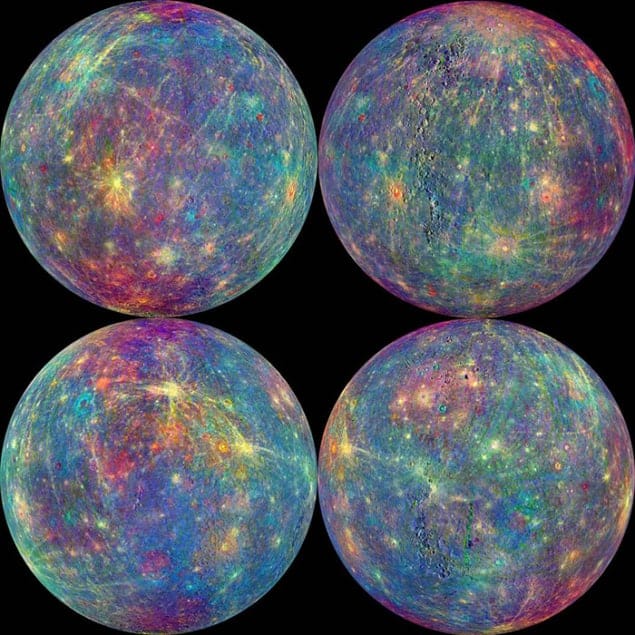
After four years studying Mercury in great detail, NASA’s $446m Mercury Surface, Space Environment, Geochemistry (MESSENGER) mission has come to an end. MESSENGER was the first spacecraft to visit Mercury since the mid-1970s, when the Mariner 10 probe flew past the planet three times. MESSENGER crashed into the planet yesterday after using up all of its fuel, while continuing to take data until the very end.
First proposed in 1996, MESSENGER was launched from Cape Canaveral aboard a Delta II rocket on 3 August 2004. It then made its way to Mercury – a 7.9 billion-kilometre journey – completing a fly-by of Earth, two fly-bys of Venus and three of Mercury itself. In 2011 MESSENGER became the first craft to orbit Mercury, with the craft entering a highly elliptical orbit around the planet that ranged from an altitude of 200 km at its nearest to about 15,000 km at its furthest point.
New discoveries
Having orbited Mercury more than 4000 times over the past four years, the 513 kg spacecraft has mapped and imaged the inner planet, worked out its geological history, discovered that its internal magnetic field is offset from the planet’s centre and found a surprising amount of water in its exosphere. MESSENGER’s nine instruments – including cameras, spectrometers and magnetometers – also uncovered evidence for past volcanic activity, as well as the possibility that Mercury has a liquid-iron core. In 2014 scientists even suggested that the probe had unearthed signs of an annual meteor shower on Mercury.
The MESSENGER spacecraft has given us much of what we now know about one of Earth’s nearest neighbours
Sean Solomon, MESSENGER principal investigator
“The history of solar-system exploration has taught us that the first spacecraft to orbit a planet, because of its global perspective and the opportunity for continuous observations over an extended period, always provides a huge increase in information,” MESSENGER principal investigator Sean Solomon, who is director of Lamont Doherty Earth Observatory at Colombia University, told physicsworld.com. “Over the last four years, the MESSENGER spacecraft, – the latest example of this lesson – has given us much of what we now know about one of Earth’s nearest neighbours.”
After running out of propellant late last year, MESSENGER began to enter a “terminal” orbit. In the last few weeks it began to use up its helium reserves that extended the craft’s operation by a couple of weeks. But with that since exhausted, the craft – travelling at around 14,000 km per hour – plummeted into the planet creating a crater some 15 m wide.
“I have worked on MESSENGER for 14 years, so seeing the end of the mission is bittersweet – it has been far more successful than any of us could ever have hoped or dreamed, but we are extremely sad to see the end of this tough and capable little spacecraft,” says Louise Procker, a planetary scientist at the Johns Hopkins University Applied Physics Laboratory who is also deputy project scientist on MESSENGER. “MESSENGER’s legacy will be huge: not only have we discovered so much about how the innermost planet evolved to its present state, we have also learned more about how terrestrial planets work, which helps us understand why the Earth is such a special place.”
Future missions
MESSENGER, however, will not be the last probe to visit Mercury. BepiColombo – a joint mission of the European Space Agency and the Japan Aerospace Exploration Agency – will pick up where MESSENGER left off. To be launched in 2017, it will comprise two satellites – the Mercury Planetary Orbiter and the Mercury Magnetospheric Orbiter – that are planned to enter orbit around Mercury in 2024. “MESSENGER’s discoveries have raised many new questions about the innermost planet, so it is heartening that two spacecraft are scheduled to be launched to Mercury two years from now,” Solomon adds.



